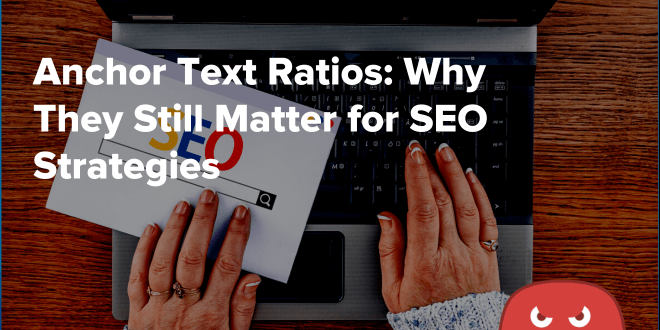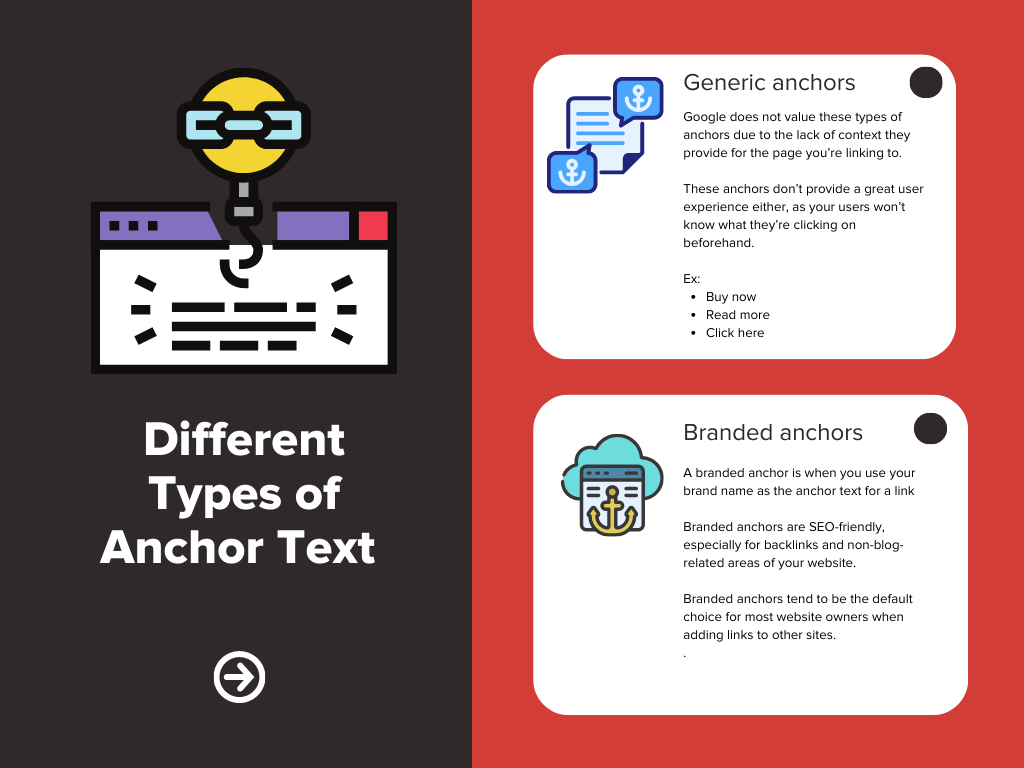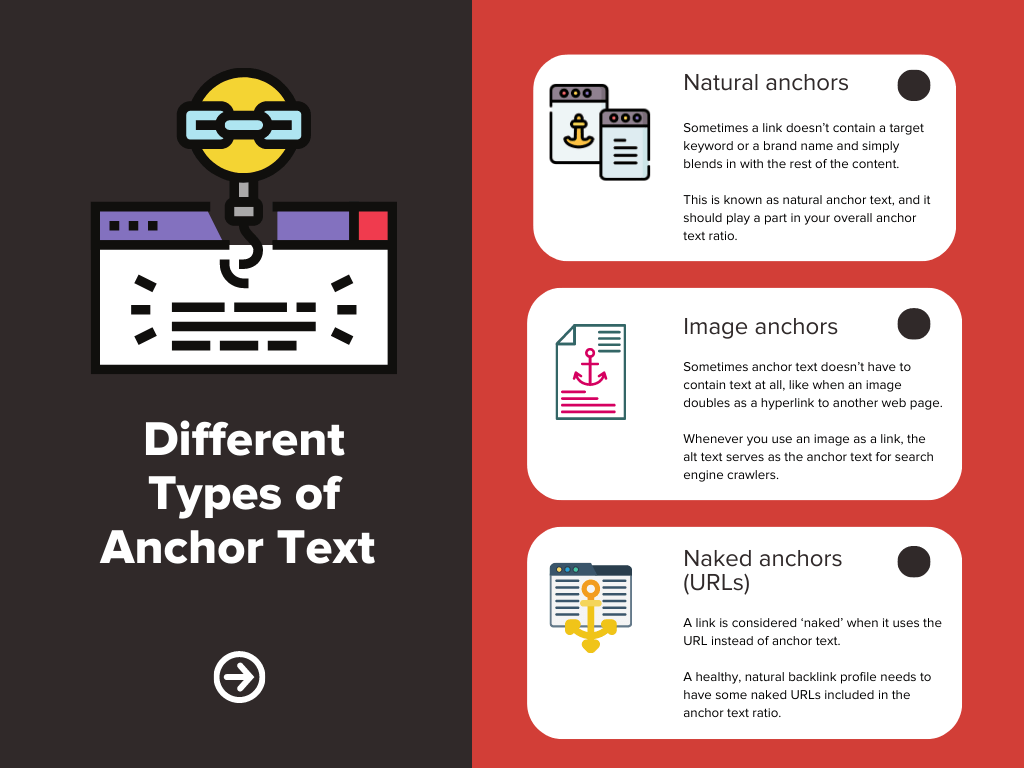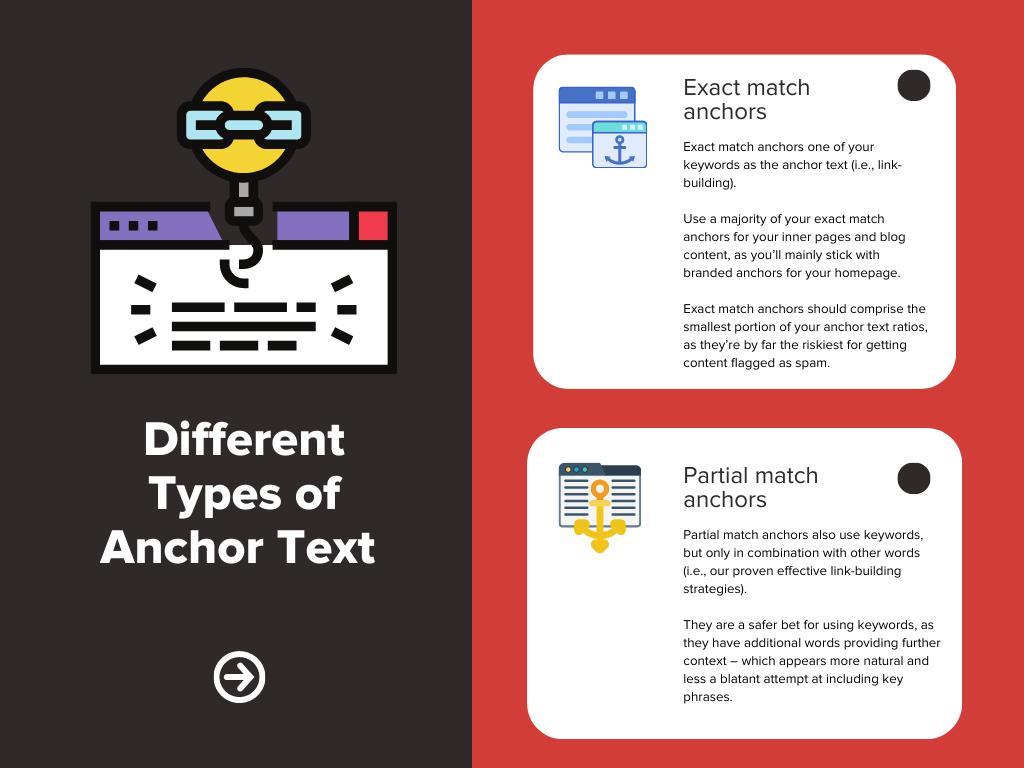Quick Links
What do backlinks, internal links, and external links all need to have the best possible impact on your link profile?
If you guessed optimized anchor text, then you’re 100% correct.
Both established and new SEOs tend to overlook optimizing their anchor text, as they’re too focused on acquiring as many backlinks as possible.
Yet, anchor text is a ranking factor, as it provides valuable context to search engines about the web pages your links point to.
Moreover, anchor text ratios are equally as important to establishing a ‘natural-looking’ link profile.
What are those?
Anchor text ratios refer to the percentage of anchor text types you use throughout your homepage and inner pages.
Believe it or not, there’s in-depth strategizing involved in choosing the type of anchor text you use for every internal link, external link, and backlink.
Options include using exact matches for your keywords (i.e., link building), partial match key phrases (i.e., link-building is essential), your brand name (i.e., The HOTH), and more.
How do we know this works?
Here at The HOTH, we’ve conducted extensive research into top-ranked Google results from countless industries to discover what a #1 ranking link profile looks like.
We were able to determine undeniable similarities in the anchor text ratios of top-ranked Google results.
In other words, we uncovered the magic ratios for achieving top-tier backlink profiles, so read on to learn how to master anchor text optimization for your website.
Understanding Anchor Text
Anchor text refers to the words that comprise a hyperlink.
For example, if we wanted you to check out our Rankings Drop Guide (hint: we do), we would insert a hyperlink to it (like we did).
As you can see, the text rankings drop guide is ‘anchored’ to a hyperlink to our blog post covering common Google rankings drop issues.
Anchor text applies to any type of link, including internal, external, and backlinks.
Sometimes links don’t contain any special text and use the bare URL as the link (i.e., www.thehoth.com), which are known as ‘naked’ links.
While it’s easy not to think too much about anchor text since it seems so basic, it actually plays a big role in your SEO (and user experience).
In fact, your anchor text is how search engines understand the context of A) the page you’re linking to and B) how it relates to the web page containing the link.
Not only that, but anchor text also provides much-needed context for your users.
For instance, let’s say that you want to link to a related blog post in one of your articles. If you don’t provide context for it through anchor text, it will confuse your readers – as they won’t know why it’s there or where it leads.
Here’s an example:
Gardening is an excellent hobby that anyone can enjoy (click here), which is why we’ve put together this beginner’s guide.
The anchor text here is far too generic and doesn’t provide any context, which is why optimized anchor text matters for search engines and users.
Google’s History with Anchor Text Ratios
In the early days of Google, less importance was placed on ‘natural-looking’ backlink profiles.
As a result, anchor text containing target keywords was the most powerful – causing many SEOs to spam their anchors with keywords.
The tactic provided impressive results, too, as keyword-rich anchor text often led to stellar rankings.
That all changed in 2012 when Google rolled out one of its most infamous algorithm updates, Penguin.
It was one of Google’s first attempts at ridding their search results of keyword spam, and it was enormously effective.
Nearly overnight, SEOs relying on keyword-rich anchor text saw their rankings come crashing down in a big way.
In the eyes of Google, spammy keyword anchors only served to game their algorithm – leading to high rankings for websites that weren’t necessarily of the highest quality (or relevant to user search queries).
Ever since Penguin, SEO has been all about making your backlink profile appear as natural as possible.
Hence, the need for utilizing anchor text ratios came about.
Instead of relying solely on keyword-rich anchor text, websites need to mix things up with different types of anchors. An example would be blending partial match anchors, brand anchors, and exact match keyword anchors.
That way, your backlink profile will appear ‘natural’ to Google, as on paper – it looks like you acquired links from lots of different sources without trying to game the system.
As stated in the intro, we’ve rigorously researched the top-ranked Google backlink profiles to determine the picture-perfect anchor text ratio.
Before we get to that, it’s essential to understand the different types of anchor text that are viable for SEO.
Understanding the Different Types of Anchor Text
There are numerous ways you can go about writing anchor text, and not all of them are good for your SERP rankings.
However, sticking to one type of anchor text isn’t a good idea either, as it’ll make your link profile appear unnatural to Google.
Here’s a look at the different types of anchor text you can use to create your anchor text ratio.
Generic anchors
First, let’s look at the type of anchor that you should NEVER use for anchor text that you want to help your SEO.
Generic anchors are basic phrases like:
- Buy now
- Read more
- Click here
- Go here
- Act now
- This website
- This page
- This one
Google does not value these types of anchors due to the lack of context they provide for the page you’re linking to.
These anchors don’t provide a great user experience either, as your users won’t know what they’re clicking on beforehand.
While generic anchors can sometimes work when combined with the CTA at the end of blog posts, your best bet is to avoid them – especially if you want your anchor text to affect your SEO positively.
Branded anchors
A branded anchor is when you use your brand name as the anchor text for a link.
In our case, a branded anchor would look like this:
Visit The HOTH to learn more about our expert white-label digital marketing services.
Branded anchors are SEO-friendly, especially for backlinks and non-blog-related areas of your website.
In fact, most of the backlinks you acquire naturally will probably use branded anchors, as it tends to be the default choice for most website owners when adding links to other sites.
This is where a catchy and well-known brand name will really help you out, as some of the most recognizable companies (think big names like Best Buy, Amazon, and Apple) get loads of backlinks just by others mentioning and linking to their brand.
Another perk is that branded anchors appear very natural to Google, so using them is always a safe bet.
Natural anchors
Sometimes a link doesn’t contain a target keyword or a brand name and simply blends in with the rest of the content.
This is known as natural anchor text, and it should play a part in your overall anchor text ratio.
Why include anchors that don’t provide any value to your SEO strategy?
While it may seem counterproductive to not include at least one keyword in the anchor text, sometimes your best bet is to refrain.
Remember, your #1 goal is to build a natural backlink profile that doesn’t scream over-optimization.
That’s why you need to include natural anchors along with branded and keyword anchors – as it’ll keep your link profile squeaky clean.
Strategically, it makes the most sense to include natural anchors whenever there’s no relevant keyword that applies to the link without sounding awkward or forced. You should also use natural anchors when it doesn’t make sense to use your brand name.
Pro tip: Just because you aren’t using keywords doesn’t mean you can’t provide much-needed context to search engines through natural anchors. Ensure that you write anchor text that provides a preview of what you’re linking to, as it’s best to avoid generic phrases even when writing natural anchors.
Image anchors
Sometimes anchor text doesn’t have to contain text at all, like when an image doubles as a hyperlink to another web page.
Whenever you use an image as a link, the alt text serves as the anchor text for search engine crawlers.
Since crawler bots lack computer vision, they won’t be able to see any images that you include in your content. The alt text lets them know what the image displays, as well as how it relates to your content (if you wrote it properly, that is).
You should include the web page’s target keyword in the alt text, as well as a brief description of what the image shows.
Including an occasional image-based link can be good for your anchor text ratios; just remember to include alt text.
Naked anchors (URLs)
As mentioned previously, a link is considered ‘naked’ when it uses the URL instead of anchor text.
A healthy, natural backlink profile needs to have some naked URLs included in the anchor text ratio, so don’t forget to use them.
Exact match anchors
Now we’re getting into anchors that use your target keywords. Exact match anchors one of your keywords as the anchor text (i.e., link-building).
You’ll want to use a majority of your exact match anchors for your inner pages and blog content, as you’ll mainly stick with branded anchors for your homepage.
Remember not to go too crazy with exact match anchors, as that’s what wrecked the rankings of countless websites whenever Penguin dropped way back in 2012.
In fact, exact match anchors should comprise the smallest portion of your anchor text ratios, as they’re by far the riskiest for getting content flagged as spam.
Partial match anchors
These anchors also use keywords, but only in combination with other words (i.e., our proven effective link-building strategies).
Partial match anchors are a safer bet for using keywords, as they have additional words providing further context – which appears more natural and less a blatant attempt at including key phrases.
What are Ideal Anchor Text Ratios?
Now that you’re well-versed in the different types of anchor text, it’s time to learn how to form the perfect anchor text ratio for your website.
There is no one-size-fits-all ratio that works for every web page, as you’ll want to use unique ratios for your homepage, blog content, and inner pages.
To determine these ideal ratios, we looked at the link profiles for thousands of #1-ranked results on Google. It took countless hours of research, but we uncovered undeniable similarities in the anchor text ratios for top-ranked results.
Here’s a look at our findings.
Homepage anchor text ratio
If you want your homepage to be as SEO-friendly as possible, here’s the anchor text ratio that you should strive for:
- 80% – 95% of your links should feature branded anchors, URLs, and natural anchor text.
- Only 10% of your links should contain partial match anchors.
- 5% or less of your homepage links should have exact match anchors.
Branded anchors, naked URLs, and natural anchors should almost entirely dominate your homepage strategy.
That’s the best way to boost your SEO profile and appear natural to Google’s crawlers.
The proof?
Here’s a look at the anchor text ratio of Overstock.com’s homepage – one of the most notorious online retail companies.

As you can see, their homepage’s anchor text ratio follows our recommendation of primarily using branded, natural, and URL anchors while ignoring anchors containing keywords (they even have 0% exact match anchors).
Inner page anchor text ratio
By inner pages, we mean your blog content, landing pages, and product pages. These pages are where you should use the most keywords in your anchors while still using discretion.
Here’s the anchor text ratio we recommend for your inner pages:
- 35% – 45% of your links should contain branded, URL, or natural anchors.
- 50% – 60% should contain partial match anchors.
- No more than 10% of your links should include exact match anchors.
Even on your inner pages, you should use exact match anchors sparingly, so stick with partial matches whenever possible.
Closing Thoughts: Anchor Text Ratios
If you want to reach the top of the Google SERPs, your backlink profile needs to contain the right anchor text ratios.
The last thing you want is to see your rankings tank because you used too many exact match anchors, so ensure that you’re strategic when writing anchor text.
The ratios found in this article come from thousands of hours of real-world research, and they’re based on link profiles that Google feels are natural and high value.
Do you need help forming a link-building strategy (including anchor text ratios) for your business?
Then you need to check out our Link Outreach and Link Insertion Services from The HOTH. Our link-building experts will help you dominate the SERPs for your niche, so don’t wait to get in touch today.












I have been using SEOjet in my campaigns for sometime now, and it is a great advantage to see both the benefits in rankings & be in the know for what your next backlink move is…. Just as the tagline suggest, “With SEOjet there is no more GuessEO”
SEOBank, I’m glad SEOJet is helping your link building efforts. With link building being so important to the success of SEO we should treat every link like the success of our business depends on that one link.
Thank you very much for this well documented and very useful post, I have just read it I have put hands to the work, greetings
AsturWebs, I’m glad it was useful for you. I was trying to provide actionable SEO advice.
I wrote a similar blog post on that not too long ago and discussed the importance of brand anchor text in your anchor text profile. I forgot to mention the difference of internal pages vs the home page and how different they can actually be in regards to anchor text ratios. I really liked how you laid out the difference between the home page anchor text ratios and internal page anchor text ratios. Thanks for sharing your research and data for internal page anchor text ratios.
Yeah it really makes a difference. I see so many people stuck on page 2 or 3 because they try to do their homepage SEO just like other pages in their site.
I use it as well and love losing the guess work in this maze of SEO. My question becomes, how do you determine which pages to rank first if you’ve got dozens that you want to rank? And, how many should you work on at a time?
PS – Thx for the hand holding when we were getting our account setup with you Adam! Really appreciated it. 🙂
Bobbi, Im glad you’re loving the software. I choose which pages to rank first based on which ones I think will have the best chance to turn visitors into buyers. There are some keywords that seem great to rank for until you get to the top of Google and then realize that none of the traffic they bring in wants to purchase anything. Really try to dial in user intent on your keywords and target those pages first, although you should build links to many pages which is more natural to do anyway.
I would still think that the speed/timing of backlinks is important – google knows the dates of all the links in a back link profile – so should that not be counted in the profile itself?
Justin, great question. I do think link recency (I just coined that phrase) matters. This is one of the main reasons you should always be building new links. But old links do hold weight and shouldn’t be ignored.
This is a good study. I’ve read in another data-backed study where they said:
“Sites in #1 had an average of 5.42% of anchor text with their keyword.”
Stan, if you look at an anchor with only a keyword and nothing else then that is pretty close to what we see. But keywords mixed in with other words happen a lot more often.
So true. Every time someone asks me to look at their site and I run it through ahrefs or majestic, I almost always see over optimized anchors – like 80%. You’ve got to mix it up and link to your BRAND, not your money page keyword phrase all the time.
You’re exactly right Carl.
Yeah, I am interested in looking further into this SEOJet stuff 😀
I have grown my DA from 1 to 34 in around 6 weeks 😀
Scott, nice work. I tend to focus less on DA and more on relevance when it comes to links. And then if I get a super relevant link with a lower DA I build links to that page to increase the SEO value.
When building links you may have some control on guest posts but when somebody else links.. well ..what can you really do? Reach out say thanks and ask him/her to change the anchor text?
Claudiu, unless you get an insane number of natural links there isnt any need to ask them to change up the anchors. In fact, with SEOJet, the link maps are going to guide you to an anchor text profile that will almost perfectly match what would happen if you got all of your links naturally.
Great research and article, Adam. This article should carry a big red warning that indicates the subject matter as “advanced”, just like Google’s disavow tool. We have found that messing up your anchor text profile can have serious consequences on rankings. Over-usage of exact keywords in anchor text was one of the main reasons so many websites lost rankings about a year ago, after one of Google’s updates.
Carlos, yeah anchor text profile is a big issue and the reason why so many sites get stuck on page 2 and 3 of the search engines.
Yes This metod still work From the past until now. I usually use this method for my clients before shooting keywords who Client Want.
Awesome data, thanks for sharing your research with us! I think a big takeaway here is that some exact match anchors are OK, but it’s certainly the least natural. Focus on branded, full URL, or mixed anchors as you call them.
Nick, you’re exactly right. Exact match anchors are an expected piece of a natural backlink profile, just a very minor piece.
Great article! For me, anchor texts were a little confusing to learn once I started looking at SEO for my website. This article is a great reminder that we really do need to diversify and not just worry about a bunch of keyword stuffing to try and rank well. Google catches on to those kind of things and it really can hurt you in the long run! Thanks for the helpful article – looking forward to more like this in the future!
Yeah, keyword stuffing is a great way to never make it to the top of Google.
I can tell you hands down SEOJet works like a charm. I have been using it on a new site for about 4 months now and the SEO rankings keep going up every month. I am sending links to about 8 pages per month. 35% to the HP and the rest to the inner pages and following the steps to a T. I know this will take longer this way but once I am at the top I will stay there in a VERY competitive niche.
Thanks Adam good shit my man 🙂
Mark, that’s awesome to hear it is working so well for you. A lot of our users are hesitant to follow the link maps exactly but if you just trust the maps you will have success for the long term.
Excellent article, I can’t believe the amount of research that must have gone into it. Did you keep industry/niche specific data of the anchor text and backlink profiles? Would be interesting to see a breakdown of top ranking sites from multiple industries and the differences in their backlink strategies.
Sam, yes we did keep track of each industry as we did the research and the biggest surprise was how closely each industry matched each other. The one major exception was the SEO industry itself. They are a different animal altogether.
how to do this rule dear ” As a rule, I try to get 1 link to my homepage for every link I get to an inner page on my site”
when i linking my inner page in guest post like “best backlinks SEO” i linking this anchor text with homepage url !! or linking anchor text brand name with linking inner page ??
Does SEOJet account for the niche when recommending anchor texts? I’ve researched Top 3 google results for a boring local business niche in 10 different cities (example: KW Dallas, KW Las Vegas, KW Atlanta, and so on). Almost all of them rely heavily on sponsor links with naked url as anchor (30%-60%), and these links come from all sorts of sites that are NOT relevant to the money site. Unless they are hiding high authority PBN’s, how can you explain the relevancy issue on this?
Happens all the time. Relevance can help but in terms of backlinks, what we’re seeing (at least now) is that raw # and power of backlinks can trump relevance. We covered a bit of this in our link building myths article and link relevance article here.
Great write-up.
Really appreciate the way you have written and explained. Worth reading it.
Thanks for sharing it with us.
Good work..!!
Thank you Clayton! This is the best article on the internet on the subject. The difference between ethos and spam is the education on how to properly optimize anchor texts. I have been guilty of over-optimizing for target keywords in my strategy. But doing it the right way, I hope to get the desired results.
Great, thanks for sharing this blog post.Really looking forward to read more.
Very indepth and well balanced article. I learned alot of new things related to anchor text. Before this i was only focusing on exact match keyword anchor then i started title tag keyword anchor etc. Anyhow this is awesome post. Keep up the great work.
Hot damn, this is a good article.
Wow. I semi-panicked as I read this article fearing my link building was shooting the proverbial foot. Doesn’t look like I ‘m off the deep end, but I will definitely be modifying my approach going forward. Thank you Clayton and Adam for this great article and research.
John Reilly
Thanks Clayton, Superb article for optimizing anchor texts for ranking fast. Great Work.
This is really very in-depth and value added information, thank you very much for such a wonderful data driven and informative article… specially 12 categories of anchor combine in to 3 main category is good idea to simplify and home & inner page profile backlink % ration is also very good.. Thanks
Great article, exactly what Ive been looking for. Is there an optimum % of links to the home page and inner pages or does it depend what the #1 website competitor is doing. Mimic there %?
Really very in-depth article. Anchor text has always been very confusing. Natural link building looks impossible unless you have very high authority. But this post given me some clarity which i am going to implement and get result. Didn’t expected so much research and analysis behind natural link building.
I love how you broke down the “3 Main Categories For Anchor Text”, sometimes I forget to mix it up and this article is a great reminder.
Anchor text is something I’ve heard lots about but found it hard to make sense. Your article is the best I’ve come across. Haven’t heard of SEO Jet till now but it looks like a great little tool. Thank you.
Hey Ginny,
Glad you found this useful, and thanks for the feedback!
This has been the most clear and concise explanation of anchor texts that I’ve found! Thanks!
Qu-1: How would you categorise an anchor text “London plumbers R Us” if the domain was “londonplumbersrus.co.uk”? Would you add this to the “Brand”, “Exact match” or “Key Phrases Mixed Into Anchor” category?
Qu-2: How would you adjust the recommended anchor text percentages for the home page if the domain is:
a) exact match (kw =”london plumbers”, dom=”londonplumbers.co.uk”)
b) phrase match (kw = “london plumbers”, dom=”londonplumbersrus.co.uk”)
c) partial match (kw =”london plumbers”, dom =”apexplumbers.co.uk”)
Thanks in advance!
Hey Greg!
1) This would be “Brand” since it’s the company name. Though I would probably capitalize each word so it’s clear it’s the brand.
2) This would depend on the context you put the link in. I’d say the ratios remain the same, even though they’re part of your domain, but Google will crawl the sentence and see how the link is contextually used to determine if it’s exact match, etc.
Thanks for the reply, and I’m glad this post was helpful!
Great article but i have one question. My exact anchor test ratio is much too high. Is it ok to change the exact match text on existing links just to reduce exact anchor match ratio or is it too dangerous for google? (unnatural and manipulating). Thnx already for answering this question 🙂
I’d create more links with natural anchor text! I wouldn’t change what’s already there, especially if you haven’t seen any direct negative impact.
Thanks for sharing valuable information about anchor text. I learn a lot from your article.
This is an excellent read, and I must say the safest anchors are Brand names or makes URLs. You will not go wrong and never penalize.
thanks YOU so much for shearing with us these Usefully information’s
I didn’t know about how much we should use keyword rich anchor text but now I’m clear. One of my page has been panelized, can I do something now to rank it again?
Yeah sure, it’s too effective article for professional and beginner.i m getting knowledge about anchor text ratio after reading it, I think this article is worth fully ..
It is important to maintain a balanced anchor text ratio to avoid over-optimization and potential penalties from search engines. A natural-looking link profile typically has a mix of different types of anchor texts. A general guideline is to aim for no more than 5-10% of exact match anchor text and to use a combination of other types of anchor text to make up the rest. However, the optimal anchor text ratio may vary depending on the specific website, industry, and competition.
thanks YOU so much for shearing with us these Usefully information’s
This article is very informative and explains the importance of anchor text optimization well. Proper anchor text optimization can provide valuable context for search engines and users. Additionally, the explanations about various types of anchor text and the recommended ratios for the homepage and inner pages are very helpful. Thank you for this comprehensive guide.
Thanks for the update
Thank you!! I have implemented this into my website.